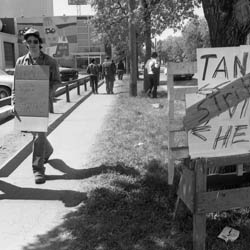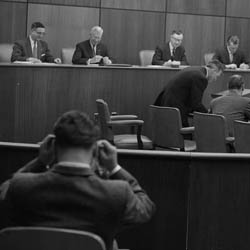Unions are democratic organizations formed by workers primarily to strengthen their position with employers regarding wages, benefits and conditions of work. The present provincial umbrella organization, the Saskatchewan Federation of Labour (SFL), represents over 95,000 members, from 37 national and international unions, with affiliate members belonging to over 700 locals. The SFL lobbies governments concerning labour legislation and the social and economic issues that affect its members. It attempts to foster labour solidarity and to present a positive face of unionism through the media. It sees itself as the primary voice speaking to the concerns of the province's more than half million wage earners and the unemployed.
In conjunction with their public advocacy efforts, unions have sought to advance their goals through political action. Some early Trades and Labour Councils supported slates of labour friendly candidates for city councils and school boards in opposition to business dominated slates. Since the creation of the CCF in 1932 Saskatchewan unionists have been closely associated with that party and its successor the New Democratic Party.
The CCF-NDP has been the province's dominant political force since the 1940s. Many of its most important achievements, including the introduction of both hospital insurance and a universal medicare plan, were supported by union leaders. One of the early acts of the CCF government when it came to power in 1944 was the passage of a Trade Union Act that became a model for unionists across the country. Saskatchewan government employees were the first in the country to be given collective bargaining rights.
More recently Saskatchewan unions have been active in promoting such issues as pay equity, respect for racial diversity, gay and lesbian rights, and improvements in the position of part time employees. Also in recent decades the close connection between labour leaders and the Saskatchewan NDP appears to have declined, due in some part to conflicts between public sector unions and NDP led governments.
Many of the earliest Saskatchewan unions were created by leaders with labour organizations in the USA and Great Britain. Most of the successful early unions were specialized trades or craft unions, representing skilled trade workers such as printers, plumbers, bricklayers, carpenters and transit drivers. Some local workers belonged to unions that had organised national bodies such as the railways. Early union membership in Saskatchewan was quite small, numbering just 3,000 in 1911 and rising to only 8,692 in 1931.
As the century progressed the membership in craft unions was challenged and eventually overtaken by those represented by industrial unions. Industrial unions attempt to organize all the workers in the same industry or business into the same union regardless of skill or trade. An unprecedented growth of government services in the 1950s and 1960s necessitated the rapid expansion of federal, provincial and municipal bureaucracies. Most of these new employees became members of public service unions, such as PSAC (Public Service Alliance of Canada), SGEA (Saskatchewan Government Employees' Association) and CUPE (Canadian Union of Public Employees). With the growth of public sector unions, many of whose members are women, females now constitute a much higher percentage of Saskatchewan union membership.
The agricultural sector, where wages have traditionally been low and workplace injuries high, has successfully resisted most attempts at unionization.
Research did not turn up a huge number of photographic images that could be said to well document the long history of the labour movement. It was only in the late 1960s that scholars began to show interest in the study of working class history and the contributions of unions. There do not appear to be a wealth of papers from union organizations and labour leaders in Saskatchewan archives. One notable exception would be the large and very rich collection of labour papers bequeathed to the University of Saskatchewan Archives, by labour historian and CUPE leader Glen Makahonuk.
Three types of union images appear commonly appear in the surveyed collections. First are posed photographs of local memberships, and of their leaders, table officers and shop stewards. Second there are a good number of photos of Labour Day parades and special events. In 1894 the Canadian parliament enacted Labour Day as an official statutory holiday to recognize the contributions of workers. Some of the earlier observances were held in April, June and July. Labour Day is now celebrated in Canada on the first Monday of September. The importance of the day's original purpose, as with other statutory holidays, now appears to be much less appreciated if one judges from the much larger turnouts to parades depicted in the earlier photos.
The third and final type of union image found in abundance are photographs of union demonstrations and picket lines established during strikes and lockouts. The photos tend to the formulaic - single or small groups of unhappy and isolated picketers waving placards outside their workplaces. Occasionally the pictures depict dramatic conflict on the picket line with police or strikebreakers. Many of these images were originally produced and used in newspapers or on television. Only a few media pictures were found of union members voting on contract proposals, or for that matter documenting any of many other types of union activity. One might well be left with the quite mistaken idea that most labour negotiations result in strikes or lockouts.




![C.W.A. Local C #2 Stewards, ['19--?']](cropthumbs/B-9664.jpg)

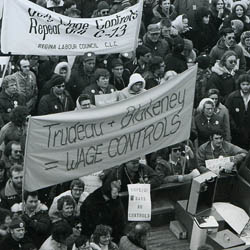
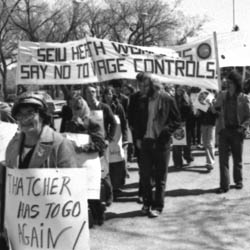
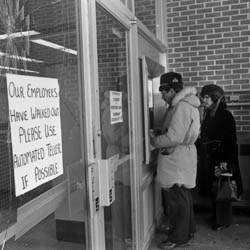
![Quaker Oats Workers Picketing, ['ca. 1969']](cropthumbs/QC-4617-1.jpg)
